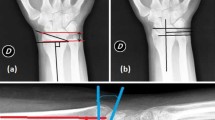Abstract
Background
There are many methods of treatment for fractures of the wrist and it is true to say that Orthopaedic surgeons are undecided as which method of treatment is best. The particular method of treatment will depend both upon the preference and experience of the surgeon and will also depend upon the nature of the fracture. In particular there are many methods about treatment of extra-articular distal radius fractrures type A2. A3 (Colles fractures). It is also worth saying that traditionally treatment of these fractures has been guided by the statement of Colles in his original paper who said that people with these fractures do well even if the fracture isn’ reduced. This has meant that these fractures have tended to be under treated in the past although most Orthopaedic surgeons now realise that treatment of these fractures is important if later problems are to be avoided. This is particularly true these days when patients place greater demands upon their wrists and are less willing to accept limitations of movement and/or pain.
Patients and Methods
In this paper, we report our experience with a new plate that has been in use in Europe since April 2005. It is a fixed-amgle intrafocal nail plate.
Results
We have treated 25 patients in a period from October 2005 to may 2007. After one year we can only provide provisional results. In all patients we have had a early restart of they common way life without complications though there are, in litterature, cases of rupture of the thumb extensor tendon.
Conclusions
The nail plate always has a firm place in our daily routine for those cases where a stable osteosynthes is indicated and in patients that required greater demands upon their wrists and are less willing to accept limitations of movement.
Similar content being viewed by others
Bibliografia
Orbay JL, Touhami A, Orbay C (2005) Fixed angle fixation of distal radius fractures through a minimally invasive approach. Tech Hand Up Extrem Surg 9:142–148
Müller ME, Nazarian S, Koch P, Schatzker J (1990) The comprehensive classification of fractures of long bones. Springer-Verlag, Berlin Heidelberg New York:106–115
Nesbitt KS, Failla JM, Les C (2004) Assessment of instability factors in adult distal radius fractures. J Hand Surg [Am] 29:1128–1138
Mackenney PJ, McQueen MM, Elton R (2006) Prediction of instability in distal radial fractures. J Bone Joint Surg Am 88:1944–1951
McCall T, Conrad B, Badman B, Wright T (2007) Volar versus dorsal fixed-angle fixation of dorsally unstable extra-articular distal radius fractures: a biomechanic study. J Hand Surg [Am] 32:806–812
Author information
Authors and Affiliations
Corresponding author
Rights and permissions
About this article
Cite this article
Trevisan, M., Mantovani, A., Espen, D. et al. Il chiodo-placca dorsale DNP: note di tecnica chirurgica. LO SCAL 22, 121–124 (2008). https://doi.org/10.1007/s11639-008-0101-8
Published:
Issue Date:
DOI: https://doi.org/10.1007/s11639-008-0101-8




